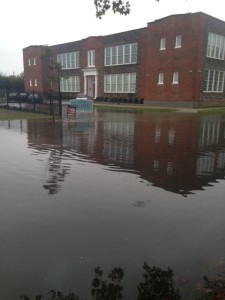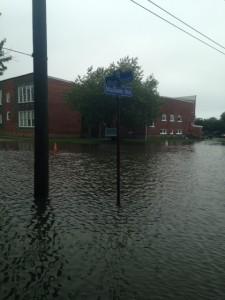 Old School developer, J. David McCormack, who has enjoyed a cozy relationship with the Town of Cape Charles, has once again found himself in court due to his dealings with another renovation project. McCormack, Waukeshaw Development, Haas Construction and the City of Martinsville are being sued by paint and drywall contractor Rojas-Stevens for lack of payment of invoices for work on the historic Henry Hotel in Martinsville, Virginia. According the owner, Ms. Daisy Rojas, McCormack failed to make payment based on work that had not been completed by other contractors (similar to a mechanics lien). Rojas also claims that this is a pattern with this group of developers, and that they routinely choose subcontractors that are smaller, minority owned, and less able to, or even unwilling to fight back.
Old School developer, J. David McCormack, who has enjoyed a cozy relationship with the Town of Cape Charles, has once again found himself in court due to his dealings with another renovation project. McCormack, Waukeshaw Development, Haas Construction and the City of Martinsville are being sued by paint and drywall contractor Rojas-Stevens for lack of payment of invoices for work on the historic Henry Hotel in Martinsville, Virginia. According the owner, Ms. Daisy Rojas, McCormack failed to make payment based on work that had not been completed by other contractors (similar to a mechanics lien). Rojas also claims that this is a pattern with this group of developers, and that they routinely choose subcontractors that are smaller, minority owned, and less able to, or even unwilling to fight back.
The Mirror attempted to contact Mr. McCormack through his Waukeshaw Development channels to get his perspective on the case, but did not receive a response.
The Henry Hotel and the Cape Charles High School: brothers in arms
Like the Cape Charles High School, the Henry Hotel, built in the 1920s, is considered a historic property in Martinsville’s designated Historic District, which means, like the old school, tax credits from the Department of Historic Resources can be leveraged to defray some or all of the renovation costs. Before McCormack, the Henry served the community by providing housing for underserved, low income (some with special needs) residents.
The City of Martinsville owned the building, and hoped to find a way to leverage it as a way to move out pesky low income residents, and move in a wealthier class. Martinsville calls this the “Uptown Living Movement”. This should sound familiar to the Cape Charles ‘tourist mantra’. The former low-income residents of the Henry have all been displaced thanks to “Uptown Living”.
Enter McCormack and Gaskins
Martinsville needed a developer to come to the rescue, and they found the familiar faces of Dave McCormack of Waukeshaw Development in Petersburg and longtime partner, Edwin Gaskin, of Echelon Resources. Selling the old Cape Charles High School for a mere $10 may have seemed dubious at the time, yet compared to the Henry Hotel, the deal now looks downright shrewd. McCormack purchased the 26,400-square-foot building from Martinsville for $1, of course, using historic state and federal tax credits (mainly from the Virginia Department of Historic Resources) as the financial lynchpin for future outlays. He also received a $600,000 grant from the state Industrial Revitalization Fund for the project.
Always somewhere to be found around these so-called historic renovations of the McCormack-Gaskins development team is Virginia Community Capital (VCC). VCC’s relationship has worked well in the past, providing the financial foundation for this team to move in on smaller markets with distressed, low-income, underserved communities with local officials looking for a savior to do the hard work for them. We’ve seen this play out, not only in Cape Charles, but in Blackstone, Petersburg, Chatham and now in Martinsville.
McCormick, Gaskins and their associates at VCC, as well as the Department of Historic Resources like to use the term revitalization as a way to infer that they are working to help underserved geographies, but in the end, the outcome is what many see as high margin gentrification. To get these projects over the goal line, the method usually employed is to create an urban mythology, focusing on neighborhood blight, and just how much it is going to cost the local government to remedy it. As an example, see this text from the Waukasha website: This old school was burning a hole in the Town of Cape Charles’ metaphorical pockets. Waukeshaw proposed a renovation into 17 residential units and the Town responded, rezoning the property in 2012.
How exactly was the school burning a hole in the Town’s ‘metaphorical’ pockets? This is the same town that wouldn’t spend $10 to fix a broken window to stop water from coming inside, and used the school as garbage dump for close to eight years.
 The rezoning statement is correct, and points to a severe lapse in the legal process, a process that led to a robust court challenge by local grass roots organization, ‘Old School Cape Charles.’ Zoning the structure R-3, with a density of up to 95 residents in what was clearly a quaint, family R-1 district, seemed detrimental and foolish, and would damage property values after the renovation eventually goes south. The Historic District Review Board, at the time led by Russ Dunton and historian Jan Neville, denied the Certificate of Appropriateness for the project, noting that a 17 apartment complex in the heart of the historic residential district, as well as overlooking the Town’s Central Park, was hardly appropriate. However, Town Council broke from the HDRB, overruling that decision (Dunton, Neville and Bob Sellars eventually resigned from the HDRB after a similar decision involving the Hotel Cape Charles was overturned by Town Council).
The rezoning statement is correct, and points to a severe lapse in the legal process, a process that led to a robust court challenge by local grass roots organization, ‘Old School Cape Charles.’ Zoning the structure R-3, with a density of up to 95 residents in what was clearly a quaint, family R-1 district, seemed detrimental and foolish, and would damage property values after the renovation eventually goes south. The Historic District Review Board, at the time led by Russ Dunton and historian Jan Neville, denied the Certificate of Appropriateness for the project, noting that a 17 apartment complex in the heart of the historic residential district, as well as overlooking the Town’s Central Park, was hardly appropriate. However, Town Council broke from the HDRB, overruling that decision (Dunton, Neville and Bob Sellars eventually resigned from the HDRB after a similar decision involving the Hotel Cape Charles was overturned by Town Council).
The curious part is the way the loans are structured– these entities only have to hold the note for two years. After that, they can flip it, and then it’s off to the next humanitarian effort in some poor, low income area where the politicians don’t possess the energy or intellectual stamina, and are just looking for a quick fix. Meanwhile, residents, such as those in the historic district of Cape Charles, are left holding the bag, helplessly watching as the one time breezy structure succumbs to natural entropy, and degenerates with no one with any skin in the game left to look after it.
These groups would not engaged with poor and underserved communities of this state unless there was money to be made. This pattern could not exist without the support and funding from entities like the Department of Historic Resources and the VCC. Historical integrity does not seem to be the motivating factor in the decision to dole out tax credits to entities like Waukesha. During the old school project, the DHR was aware that the town demolished historically significant features in front of the school (flagpole and stanchions) to make room for parking that was clearly illegal (you cannot put parking in ‘front’ of a renovated historic structure). To get around this rule, the DHR was also aware that the school property’s address was changed from 23 Park Row to 423 Plum Street, even as the front door entry is clearly Park Row. This of course, is business as usual. After numerous FOIA requests, we, the citizens have been unable to find out when the school property’s address was changed from 23 Park Row to 423 Plum Street and we have not been able to find any records of the removal of the flagpole and stanchions. The only response that has been received from the Town was from Councilwoman Natali, who (ignoring the rules of order), silenced Mayor Sullivan just before she answered Councilman Wendell’s query about whether or not the front of the school was 23 Park Row by blurting out , ‘Don’t answer that.’
There were a lot of moving parts in the eloquent old school deal, and probably the same is true of the Henry Hotel–someday, the citizens may finally know all the details.
Discover more from CAPE CHARLES MIRROR
Subscribe to get the latest posts sent to your email.
I know there is a lot to cover in the Old School fiasco, but one of the most remarkable aspects of the enterprise was what appeared to be an open and shut case of insurance fraud that the Virginia State Police refused to investigate. The Town paid McCormack $41,000 from its claim of earthquake damage. E-mails revealed the whole scam behind it. The icing on the cake was when the wall was ‘fixed’ for a couple of thousand dollars.
So Gaskin and McCormack have found yet another community to relieve of its public assets. I guess Gaskin just does not stay busy enough wth his day job. He was the Director of Economic Development for Hanover County last I heard. That sounds like another familiar story.
This is a good article, and I appreciate the background, but it’s “mechanic’s lien,” not “mechanics lean.” look it up: https://en.wikipedia.org/wiki/Mechanic%27s_lien
Good for Daisy Rojas-Stevens. Her company painted our offices and they do good work.
Editor’s Note: Thanks for the correction (we never heard of it until we were contacted by Ms. Rojas about the litigation).
Interesting article we seem to have a similar story here in our little town of Bedford Virginia with Mr. McCormick. I just wonder how many towns
Have deals with him and his partner and where all that money is going? That would make for an interesting story. I’ve heard mention of Amherst, Chatham, and others.